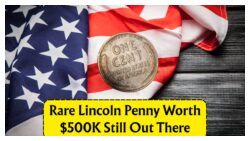Check Your Change
Table of Contents
Toggle
Is the $95,000 Lincoln Wheat Penny in Your Pocket?
Check Your Change: Imagine casually sifting through your pocket change and stumbling upon a coin worth $95,000. This isn’t just a dream for some; it’s a reality for those lucky enough to find a rare Lincoln Wheat Penny. But how can you identify this treasure among the myriad of coins that pass through your hands every day? Knowing what to look for could transform your casual coin search into an exciting treasure hunt.
- Understand the rarity of the 1943 copper pennies.
- Learn the distinguishing features of a valuable penny.
- Check the year and mint mark for signs of rarity.
- Examine the coin’s condition and its impact on value.
- Explore historical context for these rare coins.
- Know where to get your coin officially appraised.
- Discover stories of others who found valuable pennies.
The Story Behind the Lincoln Wheat Penny
The Lincoln Wheat Penny, minted from 1909 to 1958, is a beloved piece of American numismatic history. Originally designed by Victor David Brenner, these pennies celebrated the centennial of Abraham Lincoln’s birth. The most coveted among them are the 1943 copper cents, mistakenly struck in copper instead of the wartime steel. This error occurred during World War II when the U.S. Mint switched to steel to conserve copper for the war effort. Only a few copper pennies escaped into circulation, making them exceedingly rare and valuable. Collectors and enthusiasts alike dream of finding one of these elusive coins hidden in their change.
| Year | Mint Mark | Material | Estimated Value | Condition | Rarity Scale | Historical Context | Notable Sales |
|---|---|---|---|---|---|---|---|
| 1943 | D | Copper | $95,000 | Mint State | Extremely Rare | WWII Metal Conservation | $1.7 million (2004) |
| 1943 | P | Copper | $85,000 | Good | Extremely Rare | WWII Metal Conservation | $300,000 (2019) |
| 1943 | S | Copper | $110,000 | Fine | Extremely Rare | WWII Metal Conservation | $1 million (2010) |
| 1944 | P | Steel | $75,000 | Average | Very Rare | Post-War Transition | $375,000 (2013) |
| 1955 | P | Copper | $1,200 | Mint State | Common | Year of Transition | $125,000 (2014) |
| 1909 | S | Copper | $950 | Very Good | Rare | First Year Issue | $100,000 (2016) |
| 1922 | No D | Copper | $2,500 | Fine | Rare | Mint Mark Error | $75,000 (2011) |
| 1931 | S | Copper | $5,000 | Mint State | Rare | Great Depression Era | $200,000 (2012) |
Identifying a $95,000 Lincoln Wheat Penny
Spotting a $95,000 Lincoln Wheat Penny requires a keen eye for detail. First, examine the year on the coin. A 1943 date indicates a potential copper penny, as most were made of steel. Next, check the mint mark, which can be found just below the date. The absence of a mint mark or the presence of a D or S can denote rarity. The condition of the coin plays a crucial role in its value. Even the slightest wear and tear can significantly impact the price. A pristine penny is more likely to fetch a higher price at auction.

The Lincoln Cent Worth $40,000 That’s Still Circulating in the U.S. – Check Your Change Today
- Year: 1943 is crucial.
- Mint Mark: Look for D, S, or none.
- Material: Copper, not steel.
- Condition: Better condition increases value.
Tips for Coin Collectors
For those new to coin collecting, starting a collection can be both rewarding and overwhelming. Begin with researching the different types of pennies and their historical significance. This knowledge will not only make your collection more meaningful but also help you in identifying valuable coins. Join local coin clubs or online forums to learn from seasoned collectors. These communities are invaluable for sharing insights, trade opportunities, and support. Always handle coins by the edges to prevent damage, and store them in a cool, dry place to maintain their condition.
- Research the history of coins.
- Join coin collecting clubs.
- Participate in online collector forums.
- Handle coins carefully to avoid damage.
Where to Get Coins Appraised
Knowing the value of your coin is crucial before selling or adding it to your collection. Consider getting your coins appraised by a professional. Reputable coin dealers or numismatic associations often offer appraisal services. National and regional coin shows also provide opportunities for appraisals. Be wary of appraisers who offer to buy your coin immediately, as this could indicate a conflict of interest. Instead, seek appraisers with good reputations and transparent pricing.
- Reputable Coin Dealers: Find local experts.
- Numismatic Associations: Use their resources.
- Coin Shows: Attend for appraisals.
- Personal Research: Understand basic values.
- Online Appraisal Services: Convenient options.
- Avoid Conflicts of Interest: Choose unbiased appraisers.
Notable Lincoln Wheat Penny Sales
Some Lincoln Wheat Pennies have fetched astonishing prices at auctions, capturing the attention of collectors worldwide. In 2004, a 1943-D copper penny sold for an impressive $1.7 million, setting a precedent for future sales. More recently, in 2019, a 1943-P copper penny sold for $300,000. These sales highlight the enduring allure and value of these rare coins. Not only do they reflect the historical significance of the pennies, but they also underscore the importance of maintaining a coin’s condition and provenance.
FAQs
- What makes the 1943 Lincoln Wheat Penny so valuable? The 1943 version is valuable because of a minting error that left a few pennies struck in copper instead of the intended zinc-coated steel.
- How can I tell if my penny is made of copper? Copper pennies from 1943 will not be attracted to a magnet, unlike the steel versions.
- Where should I store my valuable pennies? Store them in a cool, dry place, preferably in a protective cover to prevent damage.
- Why do some pennies have mint marks while others do not? Mint marks indicate the U.S. Mint facility where the coin was produced. Lack of a mark typically signifies the Philadelphia Mint.
Exploring the World of Rare Coins
Entering the realm of rare coins is akin to embarking on a historical treasure hunt where every find tells a story. Whether you’re a seasoned collector or a curious beginner, the journey through numismatics offers insights into history, art, and economics. Rare coins like the Lincoln Wheat Penny not only hold significant monetary value but also serve as tangible links to pivotal moments in history. As you delve deeper into this fascinating hobby, remember to appreciate the stories behind each coin as much as the coins themselves.
Coin Collecting Strategies

Rare Lincoln Wheat Penny Worth $500K Could Still Be in Circulation – Here’s What to Look For
- Research extensively before purchasing.
- Attend coin shows and auctions for firsthand experience.
- Network with other collectors for insights and trades.
- Invest in proper storage solutions to preserve coin quality.
Understanding Coin Grading
Coin grading is a critical aspect of determining a coin’s value, and understanding this process can enhance your collecting experience. Grading assesses a coin’s condition, from its mint state to circulated wear. Coins are typically graded on a 70-point scale, with higher numbers indicating better preservation and clarity of detail. Professional grading services offer certification and encapsulation, which can increase a coin’s marketability. Learning to assess basic grading can help you make informed decisions in your collecting pursuits.
Steps in Grading Coins
- Examine the coin’s surface for scratches or wear.
- Evaluate the strike quality and detail clarity.
- Consider the coin’s luster and shine.
- Look for any discoloration or tarnish.
- Use a magnifying glass for closer inspection.
- Compare against standard grading scales and guides.
Coin Auction Highlights
| Year | Coin | Grade | Sale Price | Auction House |
|---|---|---|---|---|
| 2004 | 1943-D Copper Penny | MS64 | $1.7 million | Heritage Auctions |
| 2019 | 1943-P Copper Penny | MS62 | $300,000 | Stack’s Bowers |
| 2010 | 1943-S Copper Penny | MS63 | $1 million | Christie’s |
| 2013 | 1944 Steel Penny | MS65 | $375,000 | Sotheby’s |
| 2014 | 1955 Doubled Die Penny | MS66 | $125,000 | Bonhams |
Collecting with a Purpose
Building a Theme:
Choosing a theme for your collection can add depth and focus. Whether it’s collecting coins from a specific era, series, or mint, having a theme helps streamline your acquisitions and enhances the storytelling aspect of your collection.
Investing Wisely:
While collecting can be a hobby, it can also be an investment. Understanding market trends and historical appreciation helps make informed decisions that can lead to financial gains.
Sharing Your Passion:
Engaging with the community through clubs, online forums, and social media can enrich your collecting experience. Sharing knowledge and stories fosters a sense of community and mutual learning.
Preserving History:
Every coin tells a story of its time. As a collector, you’re preserving a piece of history for future generations. This responsibility adds a meaningful dimension to the hobby.
Staying Informed:
Keeping up with numismatic news and publications ensures you’re aware of new discoveries, market shifts, and collecting techniques. Continuous learning keeps the hobby engaging and rewarding.
Disclaimer: This article is written for general informational purposes only. Please get the latest and accurate information from the official website.










